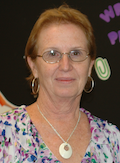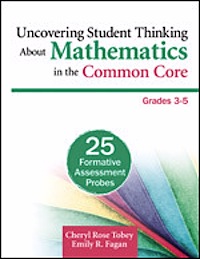Understanding Student Thinking in Math
Uncovering Student Thinking About Mathematics and the Common Core (Grades 3-5)
By Cheryl Rose Tobey and Emily R. Fagan
(Corwin Publishers, 2014 – Learn more)
 Reviewed by Linda Biondi
Reviewed by Linda Biondi
Take the guesswork out of math assessment. Speaking mathematically, that sums this book up. The authors include 25 field-tested, easy to use and understand math assessment probes that can help upper elementary teachers modify students’ understanding of Common Core math concepts. (There’s also an edition available for grades 6-8.)
As I read the book, I had a déjà vu experience. I remember sitting in the faculty room and lamenting: “Our students don’t know how to answer open ended questions. They can do basic computation but have difficulty explaining the how of solving a problem.” Uncovering Student Thinking About Mathematics in the Common Core is the mathematical road map that will provide the teacher with explicit directions on how to teach our kids to master open ended math questions and problems.
Today’s mathematics teachers are experiencing changes in the way they teach mathematics as well as the content they teach. It is no longer a lecture approach where kids sit in neat lines, practicing the art of skill and drill. Teachers are being asked to teach to a diverse group of students with active, differentiated learning approaches to help students understand the how and why of math.

Probing student understanding
As teachers begin to differentiate their lessons, they need more and varied types of data about their students’ mathematical understanding to ensure that each student is grasping the material and being able to apply it. Using OEQs (Open Ended Responses) or Constructed Response Assessment (CRA) is one way of gathering that critical data. Using Open Ended Responses gives the students a chance to explain their thinking in more than one way.
The formative assessments (termed “assessment probes”) in this brand new book by Cheryl Rose Tobey and Emily Fagan correlate with the Common Core Standards for third, fourth and fifth grades. Simply put, they are called probes because they are designed to “probe and uncover student thinking.”
The probes serve as a tool to aid the teacher in diagnosing the students’ current understanding of the material and to assess whether students are able to integrate that knowledge into more complex levels of understanding. This book is not meant to replace the math curriculum or current textbook, but to guide teachers in making instructional choices based on the needs of their students. It is a handbook!
What’s inside the book
There aren’t any surprises in the structure of this book. Each chapter follows the same format with a chart to align the standards with related questions and probes, sample student responses, Teacher Notes, reproducibles, and research-based tips. Each reproducible is designed with developmentally appropriate assessments that function as an diagnostic tool to drive teaching, not as a testing instrument. After administering the assessment, you can quickly determine “where do we go from here?”
Of course, being the eager reader that I am, I quickly skimmed through the book to determine what other goodies I would find. To my delight, the concluding chapter “Additional Considerations” was a goldmine! Some of the topics: Establishing Learning Targets; Individual Metacognition and Reflection (The 4Cs); Giving Student Interviews; Addressing Individual Needs; Promoting Math Talk; Professional Collaboration.
I was impressed and inspired by the chapter’s opening quotation: “An assessment activity can help learning if it provides information that teachers and their students can use as feedback in assessing themselves and one another and in modifying the teaching and learning activities in which they are engage.” (Black, Harrison, Lee, Marshall & William, 2004)
Overall, I found the book to be fascinating. At first I was impressed because it was organized according to the mathematical strands: Operations and Algebraic Thinking, Number and Operations (Base Ten), Number and Operations( Fractions), Measurement and Data, and Geometry/Geometric Measurement. This book concludes with a chapter on additional considerations. Appendix A. Information on the Standards for Mathematical Practice, Appendix B. Developing Assessment Problems, Appendix C. Action Research Reflection Template QUEST Cycle, a list of references, and an index.
The excellent Teacher Notes
One thing that sets this book apart from other books about the teaching of math is the “Teacher Notes.” We expect our students to be able to verify their answers to a problem by explaining how they reached an answer. This book provides the teacher with a detailed explanation of how to interpret the students’ answers and their understanding of the key concepts. Teacher Notes for each probe are organized around a QUEST Cycle, an Action Research Reflection Template.
- Questioning student understanding: Determine the key mathematical understandings you want students to learn.
- Uncovering student understanding: Use a Probe to uncover understandings and areas of difficulties.
- Examining connections to research and educational literature: Prepare to answer the question, in what ways does your students’ understanding relate to those described in the research base?
- Surveying the student responses: Analyze student responses to better understand the various levels of understanding demonstrated in their work.
- Teaching implications: Consider and follow through with next steps to move student learning forward.
Imagine having a mentor by your side every moment of math instructional time! Imagine someone guiding you to circumvent common misconceptions and difficulties that students may experience and giving you ideas to plan instruction! Imagine someone whispering in your ear, pointers and tips that will help you quickly determine where the roadblocks to learning a specific concept may occur! Imagine having someone inspiring you to explore ways to respond to the students’ difficulties and strengths in order to move their learning forward with rigor!
You don’t need to imagine. It’s all there in the book, Uncovering Student Thinking About Mathematics and the Common Core (Grades 3-5). Teachers from grades three to five will find the book a tool that they will keep at their side. The probes are easily adapted for students who haven’t met the standards at their grade level. As a teacher who has taught third, fourth and fifth grades, I find this invaluable.
Uncovering Student Thinking About Mathematics and the Common Core (Grades 3-5) is one of the best mathematics assessment books I have read! I found this an easy book to connect with, and I would recommend it (or one of the other grade-level versions) to any mathematics teacher who wishes to bring more formative assessment practices into his/her classroom.
Linda Biondi is a fourth grade teacher at Pond Road Middle School in Robbinsville, NJ, and a recipient of several educational grants that infuse a literacy enriched curriculum with an understanding of individual learning styles to help students understand bias and patterns of discrimination. She is a Teacher Consultant with the National Writing Project and a participant on the NJ Department of Education Teacher Advisory Panel.
Editor’s note: Cheryl Rose Tobey and Emily R. Fagan have also written Uncovering Student Thinking About Mathematics in the Common Core, Grades 6-8.

































